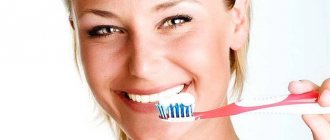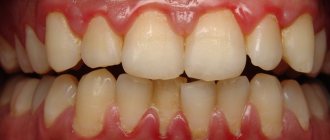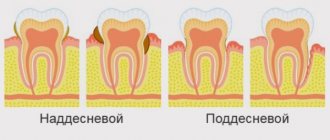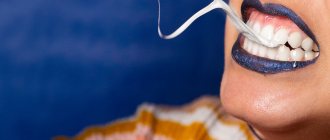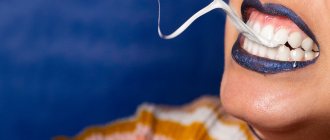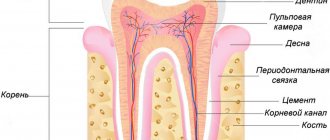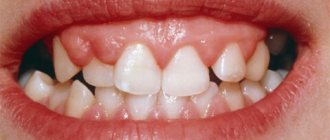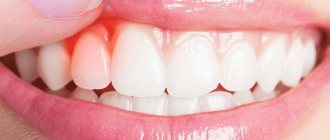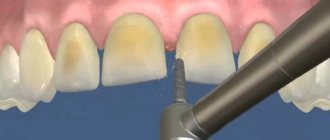Types of massage Finger massage Contraindications
Gum massage will be useful for everyone. It improves blood circulation, lymph flow, tissue metabolism, and saturates tissues with oxygen. Regular procedures increase the thickness of the epithelium, which protects the gums from the penetration of bacteria. However, there are diseases for which gum massage is an essential component of complex therapy. These are periodontal diseases: the tissues and ligaments that hold the tooth in the gum. These are gingivitis, periodontitis, periodontal disease. All of them are characterized by bleeding gums.
Gums bleed due to overgrowth of bacteria in the mouth. Most often this indicates poor hygiene, but there are cases when bleeding is caused by improper prosthetics, smoking, or internal diseases.
Gum massage is carried out in medical institutions as a physiotherapeutic procedure and at home as maintenance therapy.
Indications and contraindications
Gum massage can be performed for both preventive and therapeutic purposes. In each case, you should consult a dentist who will recommend a technique and means.
- For periodontitis, the gums are massaged only with your fingers, using smooth, slow movements. For comfort, fingers are lubricated with olive oil or toothpaste.
- For periodontal disease, special medical oils and gels are used. Massage with fingers or irrigator.
Contraindications to self-massage are:
– short period from the moment of tooth extraction, partial or complete adentia (absence of teeth);
– braces, dentures;
– inflammation in the oral cavity, purulent or bloody discharge;
– large carious lesions;
– presence of teeth/roots requiring removal.
What are the benefits of gum massage?
Let's start with the main thing - the benefits of gum massage. By stimulating the soft tissues of the oral cavity, you can guarantee the following results:
- Saturation of cells and tissues with oxygen;
- Improved blood supply;
- Strengthening periodontal tissues;
- Elimination of swelling;
- Disinfection of the oral cavity: provided that self-massage of the gums is performed using various tinctures and means;
- Prevention of carious changes.
At the same time, we should not forget that, like any massage procedure, there are indications and contraindications.
Indications for gum massage:
- Eruption of primary and permanent teeth;
- Wearing removable dental structures;
- Prevention and treatment of dental diseases;
- Correction of malocclusion;
- Gum recession (decrease in volume) with exposure of the necks and roots of the teeth.
At the same time, manual and hydromassage of the gums is contraindicated in the presence of:
- Teeth to be removed;
- Cysts, abscesses, etc.;
- Periodontal pockets: a pathology in which there is detachment of the gum from the tooth.
- Jaw injuries.
Taking these features into account, it is recommended to do hydromassage of the gums only after visiting the dentist.
Techniques
Massage the gums with your fingers (in the evening) or with a soft toothbrush (in the morning).
- Self-massage with fingers is performed with washed hands after hygienic brushing of teeth in the following sequence:
- Using light stroking movements, the pads of the index fingers of both hands move along the gum from the front teeth to the distant wisdom teeth. Repeat on each jaw 5–7 times.
- Rub the gums in a circular motion, moving along the gum from one wisdom tooth to another, gradually increasing the pressure.
- Wrap your fingers around the gum on both sides and squeeze near each tooth for 6–7 seconds, moving from the center to the far teeth.
- Complete the massage with soft strokes.
- There are several techniques for massaging your gums using a soft toothbrush:
- According to Charters. The brush is placed at the base of the teeth, massaging the enamel surface with vibrational movements up and down, capturing the edge of the gum. At the beginning of the procedure, the affected tissues are not affected.
- According to Shtilman. The brush is positioned at an angle of 45° with the bristles down, and carefully moved along the interdental spaces. During massage, not only cleaning occurs, but also increased blood flow.
- According to Bell. The brush is moved, grabbing the edge of the gum, in one direction - from the base of the teeth to the cutting edges. With slow movements, possible suppuration from the mucous membranes comes out.
- According to Fones. With the jaws closed, place the brush on the teeth at an angle of 90°. They make circular spiral movements along both rows of teeth, capturing the edge of the gums. When opening the mouth, repeat on the distal (back) side of the teeth.
- According to Hirschfeld. Pass the bristles from the neck of the teeth to the edge, capturing the edge of the gum. The direction of movement on the teeth of the lower jaw is from bottom to top, on the teeth of the upper jaw – from top to bottom.
Features of massage for periodontal disease and periodontitis
Massage for periodontal disease and periodontitis is carried out after sanitation of the oral cavity, taking into account the following features:
– gentle types of self-massage are performed with a toothbrush (according to Charters, Shtilman);
– finger massaging begins in healthy areas, gradually moving to the sick;
– after the procedure, the mouth is rinsed with a decoction of recommended herbs or a solution of tea tree oil (7-10 drops per glass of water).
To enhance the effect of the massage, applications are made - a medicinal product is applied to a cotton swab and held on the gum for 15 minutes. You can use fir oil, honey with added salt, or a mixture of 1 teaspoon of raw grated honey with the addition of 10 drops of vegetable oil.
Treatment with applications is carried out for 14 days, followed by a break.
Types of massage
Before starting a massage course, you need to sanitize your mouth. Otherwise there will be no result. The dentist treats caries, removes tartar and plaque, and only after that prescribes massage procedures.
Massage can be:
- Vacuum
It is carried out in the clinic with a special device. Vacuum massage of the gums for periodontitis and other inflammations of the mucous membrane helps stimulate the immune system, improve trophism, and saturate the blood with oxygen.
A glass tube with an extension at the end is applied to the gums for 1-4 minutes
. Due to the pressure difference, rarefied air (vacuum) is created in the tube and it sticks to the mucous membrane. Recently, vacuum therapy has been combined with laser beam irradiation. The beam is low-frequency, red spectrum. Has anti-inflammatory and analgesic effects.
- Hydrolaser
A stream of water, most often mineral, in combination with infrared laser radiation is directed onto the mucous membrane. A stream of water from the massager washes away food debris and decay products not only from interdental crevices, but also from periodontal pockets. Hydrolaser massage of gums during periodontal disease relieves pain and bleeding. Recommended for receding gums, to improve their nutrition and blood supply.
- Gum massage with an irrigator
It is carried out at home. A stream of water removes food debris from between teeth. Removes plaque from teeth. It helps well with periodontal diseases, after implantation, prosthetics with fixed dentures, and installation of braces.
A dentist or hygienist will show you how to massage with an irrigator.
- Using a brush
There are brushes for massaging the gums, but most often at home they use regular soft toothbrushes. It is recommended to massage your gums daily for at least 3 minutes in one of the following ways:
- Holding the brush at an angle of 45 degrees,
make circular movements, grabbing the gum and the place where it connects to the tooth. - With the teeth closed, circular movements are made while holding the brush perpendicularly.
The most accessible, simple and cheap method is self-massage with your fingers.
Gum massagers
Gum massagers in pharmacies are available in two types:
- for vacuum technology;
- irrigators.
The first are special devices with nozzles and small hoses that create pressure. When used during a session, 5–7 microscopic hematomas are created. As they recover, metabolic processes and active healing of the mucous membrane are stimulated.
An oral irrigator is an electric device with attachments that creates pressure of water and air. Works from a power outlet, there are portable or travel models. Used for thorough hygiene and massage.
To combat pain and bleeding, and improve periodontal health, gum massage is used. It is important to follow the technique. It is permissible to use herbal decoctions and medications for better effect and faster elimination of ailments.
How does the postoperative period proceed and recommendations?
After tooth extraction, the patient must know what happens to the gums after tooth extraction.
Table No. 1. Stages of restoration of soft and hard gum tissue:
| The progress of restoration of the gum mucosa | The progress of gum bone tissue restoration |
| bleeding after tooth extraction should end within half an hour to three hours; · after the bleeding has stopped, you can see a clot in the hole, this is what remains in the gum after tooth extraction, it is very important for normal tissue healing; sometimes the doctor puts medicine into the gums after tooth extraction; this may be necessary if the extraction was difficult; after a few days the wound is covered with a thin light film; a week after removal, the hole becomes white; from two to three weeks (depending on the complexity of removal), the final formation of the epithelial tissue occurs, the mucous membrane is completely restored. | the first two weeks, only soft tissue is restored; in the interval from the second to the fifth week, new bone tissue grows on the sides of the socket, and the inner surface of the socket gradually begins to fill with tissue; by the sixth week the entire socket consists entirely of young bone tissue, then within a week it becomes hard, mature tissue; between the third and fourth months, the new bone tissue becomes one with the jaw bones; six months after tooth extraction, bone fusion is completed and the gum bone is finally formed. |
The postoperative period can take place in different ways, it all depends on the size of the tooth, its location, and the correctness of the procedure. At the end of the procedure, you should ask the doctor how to calm the gums after tooth extraction.
Usually recommended and prescribed:
- painkillers, local or general;
- antiseptic rinses, the price of drugs for this is not high;
- gentle diet and drinking;
- hygiene procedures;
- gum massage;
- The doctor should also tell you what to apply to the gums after tooth extraction; as a rule, cold is used.
Self-massage techniques with fingers
Important: gum massage should not be carried out with a long manicure, this can damage fragile gum tissue.
You can massage your gums in different ways, focusing on healthy and problematic areas of the jaw. Massage during tooth extraction is best done using the finger method.
Here are some possible options:
- Stroking is the main tool for preventive action on the gums. They are encouraged to start and end the procedure. If, after extracting a tooth, there is a clear swollen area on the gum, then manipulations begin from a place where there is no swelling, gradually moving towards the problem area.
- Trituration. This technique involves a strong impact on the gums, which means it can only be performed after the doctor’s instructions. Rubbing is performed using spiral movements from the middle of the gum to its edges. This method has two variations: direct massage and indirect massage. Direct is performed directly on the gums, not straight - through the cheek.
- Squeezing is carried out with vertical rotational movements.
- Squeezing is a method of simultaneous compression of the gums with the index finger and thumb. In this case, one compression is very short-lived. Strength of impact: medium, no pain or tingling should be felt.
The video in this article and photos will demonstrate the difference between different massage techniques.
Important: if, at the end of the massage, something pricks in the gum after removal, you must definitely visit the dentist and talk about the symptom; you may need to cancel the procedure.
During teething in babies
To relieve teething pain in babies, there are various gels, syrups and drops that contain lidocaine. However, gum massage can no less effectively alleviate the child’s condition during this difficult period for him .
The procedure is carried out with the index finger or little finger , without treating your hands with alcohol. It is enough to wash them thoroughly with cool water, paying special attention to the area under the nails. Nails should be cut short to avoid damaging the gums; you can also use a silicone fingertip with soft bristles or a cotton swab moistened with boiled water .
The area where the roots of the teeth are located is lightly rubbed and stroked with circular movements on both sides - internal and external. Monitor your child's reaction and take short breaks so that he can adapt to unusual sensations .
Massage can be done an unlimited number of times, it is not contraindicated and has no side effects.
You only need to massage the area above the gums . Impact on the site of teething can worsen the baby’s well-being.
For periodontal disease and periodontitis (exposure of the tooth root)
With periodontal disease and periodontitis, the mucous membrane around the teeth becomes hypersensitive to temperature changes .
Bacteria begin to multiply in the interdental areas, causing inflammation and purulent discharge. The gums soften, losing their usual elasticity and begin to bleed heavily. The patient feels these symptoms every time he brushes his teeth and while eating.
When a tooth root is exposed , special medications are used for treatment, but massage , which is prescribed as an additional treatment procedure, helps to enhance their effect. The teeth are first cleaned of plaque, and the procedure itself is carried out using clean fingers. Massage significantly improves metabolic processes, gums become stronger and healthier .
The procedure is simple: you need to apply a few drops of essential oil to a cotton pad and apply to the gums for 7-10 minutes . The procedure must be performed daily for two weeks, then you should take a break .
For your information! The use of natural essential oils will greatly enhance the effect and simplify the procedure. The most beneficial oils will be mint, tea tree, lemon and eucalyptus.
Impact on active points of the body
Important: if you combine massage with rinsing to strengthen the gums, the effect of tissue restoration will occur much faster; it is customary to complete the massage with a therapeutic rinse, in addition, this will help wash away the remnants of the substance with which the procedure was performed.
Another pleasant and useful addition to gum massage is massage of biologically active points that are located on the gums. On the upper jaw they are located above the roots of the teeth, along the very top of the gums. On the lower jaw, under the roots, along the lower edge of the gums.
There are several areas that can help solve problems with the body that are not related to dentistry:
- the first and second teeth on either side of the center of the jaw are surrounded by points through which the kidneys, ears and bladder can be affected;
- through the area around the third tooth you can influence the functioning of the liver and gall bladder;
- by massaging the gums around the fourth and fifth teeth on either side of the center of the jaw, the patient has a positive effect on the functioning of the lungs and large intestine;
- the sixth and seventh teeth are surrounded by areas responsible for the well-being of the stomach, spleen and pancreas;
- the effect on the gums of the eighth teeth has a positive effect on the small intestine and the heart.
Important: the ideal option is to apply all impact methods in one massage session, starting and ending with the first technique.
Thus, a patient who has developed a good habit of massaging his gums every time he brushes his teeth has a positive effect not only on the condition and health of his gums and teeth. It also helps your body work better and successfully cope with ailments. Massage after tooth extraction will help during the rehabilitation period after the procedure, the main thing is that it is performed as intended and with the consent of the dentist.
Category: Tooth extraction Published by Mister stomatolog
Comments
Will gum massage help straighten teeth? Will this eliminate the need to wear braces? I only have 1 crooked tooth!
Anna (08/11/2020 at 08:12 pm) Reply to comment
- Dear Anna! Massage alone will not help correct crooked teeth. It is prescribed in addition to myogymnastics and other methods of bite correction. But if the patient has only one crooked tooth, then wearing braces, as a rule, is not required. The problem can be solved with removable orthodontic devices (plates, trainers), or artistic correction, prosthetics with veneers and crowns.
Editorial staff of the portal UltraSmile.ru (08/13/2020 at 09:07) Reply to comment
Is it worth giving a massage when a child’s tooth has erupted? If he scratches it actively, will massage help ease teething? Will massage speed up the appearance of new teeth? Are there any contraindications for massaging a baby’s gums?
Elena (09.23.2020 at 08:21) Reply to comment
I have fairly loose gums. I read the article and decided to try massage using the Charter method. I had never observed bleeding gums before, but now blood appeared. Tell me, should I wait and continue, perhaps this is just an adaptation of the gums, or does this already indicate the beginning of problems?
Olga (09.23.2020 at 09:23) Reply to comment
What motivates the opinion of the author of the article that gum massage helps activate points responsible for the health of various internal organs? I’m hearing this for the first time and even Wikipedia doesn’t give a clear answer!
Julia (09.23.2020 at 09:25) Reply to comment
We started massaging the baby when teething, sometimes with our fingers, and sometimes with a special massage brush. Once again, blood began to flow around the tooth (it was just emerging). Does this mean that there is no need to do massage anymore? How then can teething be made easier?
Marina (09/23/2020 at 11:28 am) Reply to comment
My gums constantly bleed when brushing my teeth, no matter what level of hardness the toothbrush is, I use toothpaste many times, nothing helps. Will massage help? Does it help reduce bleeding?
Marina (11/20/2020 at 7:00 pm) Reply to comment
Hello! I am wondering whether it is necessary to consult a dentist before starting the procedure, or can I choose the method myself and change techniques? Can making decisions on my own be very harmful to my health?
Ira (11/20/2020 at 7:16 pm) Reply to comment
I only knew the first one, the dentist once showed it to me. Is it worth doing such a massage if I have a wisdom tooth coming out, naturally there is swelling and pain, or is it better to just use some kind of ointment?
Lera (11/20/2020 at 7:27 pm) Reply to comment
Small children can still do this. I don't know about adults. If only everything was sterile. You need to do this with clean hands so as not to introduce an infection and create even more problems than they already are.
Vlad (11/20/2020 at 08:25 pm) Reply to comment
If you need to do a massage, it is better to consult a doctor. He will tell you and show you how best to do this and to avoid further problems if something happens or if the massage is incorrect.
Pavel (11/20/2020 at 9:12 pm) Reply to comment
Write your comment Cancel reply
Secrets that will make self-massage more effective
To achieve maximum results, it is recommended to first conduct a complete examination of the oral cavity, remove plaque and tartar. This can be done in a clinic or using gum massage devices.
After the procedure, you need to rinse your mouth using herbal decoctions, which enhance the massage effect, relieve swelling, and disinfect the oral cavity. In addition, it is recommended to combine several massage techniques, do hydromassage with mineral water, and use toothpastes with a therapeutic effect.
Author of the article
Contraindications to the procedure
The following factors are contraindications:
- advanced form of caries;
- suppuration in the gum pockets and fluid secretion;
- during the healing of sockets after tooth extraction;
- tartar, acute form of infectious and inflammatory diseases;
- lack of teeth;
- ulcers, oral infections (viral, bacterial, microbial, stomatitis);
- problems with blood clotting;
- malignant tumors;
- febrile state, temperature, infectious diseases.
Wearing braces and dentures requires careful massaging techniques after consultation with a doctor.
If there are restrictions, it is necessary to eliminate them: undergo drug treatment, put fillings, remove tartar, have a specialist clean the gum canals from pus.
After eliminating contraindications, agree on the possibility of performing a gum massage with the dentist, discuss the recommended techniques, and, if necessary, additional medications and solutions to increase the effectiveness of the procedure.
